R.R.O. 1990, Reg. 597: VEHICLE AND AXLE WEIGHTS, Highway Traffic Act, R.S.O. 1990, c. H.8
Highway Traffic Act
Code de la route
R.R.O. 1990, REGULATION 597
Amended to O. Reg. 186/02
VEHICLE AND AXLE WEIGHTS
Historical version for the period June 28, 2002 to June 27, 2005.
This Regulation is made in English only.
Definitions
1. In this Regulation,
“aggregate vehicle” means a vehicle or combination of vehicles that is designed for dumping or spreading of sand, gravel, crushed or uncut rock, asphalt, slag, rubble, or any mixture thereof and that is transporting a load consisting mostly of any of these materials;
“axle spread” means the longitudinal distance between the centres of the foremost and rearmost axles of an axle unit;
“base length” means the distance measured between the centres of the first axle of the front axle of a vehicle or combination of vehicles and the last axle of a vehicle or combination of vehicles;
“carbon dioxide tank semi-trailer” means a triaxle tank semi-trailer that is in carbon dioxide service and that,
(a) was built to Transport Canada specification TC331 or United States Department of Transportation specification MC331, and
(b) bears the appropriate specification number on the compliance label or manufacturer’s identification plate affixed to the vehicle;
“cryogenic tank semi-trailer” means a tank semi-trailer that was built to Canadian Gas Association specification CGA341 or Transport Canada specification TC341 and bears the appropriate specification number on the compliance label or manufacturer’s identification plate affixed to the vehicle;
“effective overhang” means the longitudinal distance from the centre of the tandem axle, in the case of a self-steer triaxle semi-trailer, or from the centre of the tridem axle, in the case of a self-steer quad semi-trailer, to its rearmost point, including any load;
“end dump semi-trailer” means a semi-trailer to which is permanently attached a body or box that is hinged and can be raised to dump from the rear of the semi-trailer;
“front axle weight” for,
(a) an aggregate vehicle means,
(i) for a single front axle, the maximum weight permitted under section 116 of the Act for a single axle,
(ii) for a dual front axle, one-half the maximum weight permitted under section 116 of the Act for a dual axle, and
(iii) for a triple front axle, one-third the maximum weight permitted under section 116 of the Act for a triple axle, and
(b) a vehicle or combination of vehicles that is not an aggregate vehicle means,
(i) for a single front axle, the axle unit weight on the front axle, or, if that weight is more than the maximum weight permitted for a single axle under section 116 of the Act, the maximum weight permitted for a single axle under section 116 of the Act,
(ii) for a dual front axle, one-half of the axle unit weight on the dual front axle, or, if that weight is more than one-half of the maximum weight permitted for a dual axle under section 116 of the Act, one-half of the maximum weight permitted for a dual axle under section 116 of the Act,
(iii) for a triple front axle, one-third of the axle unit weight for the triple front axle, or, if that weight is more than one-third of the maximum weight permitted for a triple axle under section 116 of the Act, one-third of the maximum weight permitted for a triple axle under section 116 of the Act;
“inter-axle spacing” means the longitudinal distance separating two consecutive axle units within a vehicle or combination of vehicles, measured from the centre of the rearmost axle of the foremost axle unit to the centre of the foremost axle of the other axle unit;
“inter-vehicle-unit distance”, for a combination of vehicles, means the lesser of,
(a) the distance between the centres of the last axle of the motor vehicle or road building machine and the first axle of the towed vehicle, and
(b) the distance between the centres of the last axle of the first towed vehicle and the first axle of the second towed vehicle;
“intra-vehicle-unit distance”, for a five or six axle vehicle without a towed vehicle, means the greater of,
(a) the distance between the centres of the second and third axles from the front of the vehicle, and
(b) the distance between the centres of the third and fourth axles from the front of the vehicle;
“number of axles” means the total number of axles on a vehicle or combination of vehicles that are transmitting weight to the highway;
“open-top hopper dump semi-trailer” means a semi-trailer to which is permanently attached an opened-top body or box with bottom hoppers that can be opened to dump from the bottom of the semi-trailer;
“self-steering axle” means an assembly of two or more wheels whose centres are in one transverse vertical plane and whose wheels can articulate in response to forces generated between the tires and the road or through mechanisms and linkages that operate independently of the driver;
“single semi-trailer” means a semi-trailer that is the only trailer in a tractor-trailer combination;
“tag-axle tank semi-trailer” means a tank semi-trailer,
(a) that is not more than 14.65 metres in length,
(b) that is equipped with a rear single axle and a front tandem axle, whose inter-axle spacing is more than 2.5 metres,
(c) whose single axle,
(i) is a self-steering axle capable of turning 20 degrees in either direction, and
(ii) is not a liftable axle, and
(d) whose axles automatically load equalize;
“tandem axle” means a dual axle that does not include a liftable axle or a self-steering axle and that has the same number of tires on each wheel;
“tank semi-trailer” means a triaxle semi-trailer that is permanently attached to a closed tank having a capacity of 2.3 kilolitres or more;
“tractor” means a commercial motor vehicle designed to draw one or more semi-trailers to which it is coupled by means of a fifth wheel assembly;
“triaxle semi-trailer” means any three-axle single semi-trailer that does not have a tridem axle;
“tridem axle” means a triple axle that does not include a liftable axle or a self-steering axle and that has the same number of tires on each wheel;
“wheelbase” means the longitudinal distance from the centre of the kingpin to the centre of the tandem or tridem axle of the semi-trailer, as the case may be. R.R.O. 1990, Reg. 597, s. 1; O. Reg. 355/96, s. 1; O. Reg. 668/00, s. 2 (2); O. Reg. 186/02, s. 1.
Allowable Gross Vehicle Weights
2. (1) For the purposes of section 118 of the Act and subsection 3 (2) of this Regulation, the maximum allowable gross weight for a vehicle or combination of vehicles with,
1. three axles is as prescribed in Table 1;
2. four axles is as prescribed in Table 2;
3. five axles, and having an inter-vehicle-unit distance or intra-vehicle-unit distance of less than 2.40 metres, is as prescribed in Table 3;
4. five axles, and having an inter-vehicle-unit distance or intra-vehicle-unit distance of 2.40 metres to less than 2.70 metres, is as prescribed in Table 4;
5. five axles, and having an inter-vehicle-unit distance or intra-vehicle-unit distance of 2.70 metres to less than 3.00 metres, is as prescribed in Table 5;
6. five axles, and having an inter-vehicle-unit distance or intra-vehicle-unit distance of 3.00 metres to less than 3.30 metres, is as prescribed in Table 6;
7. five axles, and having an inter-vehicle-unit distance or intra-vehicle-unit distance of 3.30 metres to less than 3.60 metres, is as prescribed in Table 7;
8. five axles, and having an inter-vehicle-unit distance or intra-vehicle-unit distance of 3.60 metres or more, is as prescribed in Table 8;
9. six axles, and having an inter-vehicle-unit distance or intra-vehicle-unit distance of less than 2.10 metres, is as prescribed in Table 9;
10. six axles, and having an inter-vehicle-unit distance or intra-vehicle-unit distance of 2.10 metres to less than 2.40 metres, is as prescribed in Table 10;
11. six axles, and having an inter-vehicle-unit distance or intra-vehicle-unit distance of 2.40 metres to less than 2.70 metres, is as prescribed in Table 11;
12. six axles, and having an inter-vehicle-unit distance or intra-vehicle-unit distance of 2.70 metres to less than 3.00 metres, is as prescribed in Table 12;
13. six axles, and having an inter-vehicle-unit distance or intra-vehicle-unit distance of 3.00 metres to less than 3.30 metres, is as prescribed in Table 13;
14. six axles, and having an inter-vehicle-unit distance or intra-vehicle-unit distance of 3.30 metres to less than 3.60 metres, is as prescribed in Table 14;
15. six axles, and having an inter-vehicle-unit distance or intra-vehicle-unit distance of 3.60 metres or more, is as prescribed in Table 15;
16. seven axles, and having an inter-vehicle-unit distance of less than 2.10 metres, is as prescribed in Table 16;
17. seven axles, and having an inter-vehicle-unit distance of 2.10 metres to less than 2.40 metres, is as prescribed in Table 17;
18. seven axles, and having an inter-vehicle-unit distance of 2.40 metres to less than 2.70 metres, is as prescribed in Table 18;
19. seven axles, and having an inter-vehicle-unit distance of 2.70 metres to less than 3.00 metres, is as prescribed in Table 19;
20. seven axles, and having an inter-vehicle-unit distance of 3.00 metres to less than 3.30 metres, is as prescribed in Table 20;
21. seven axles, and having an inter-vehicle-unit distance of 3.30 metres to less than 3.60 metres, is as prescribed in Table 21;
22. seven axles, and having an inter-vehicle-unit distance of 3.60 metres or more, is as prescribed in Table 22;
23. eight or more axles, and having an inter-vehicle-unit distance of less than 2.10 metres, is as prescribed in Table 23;
24. eight or more axles, and having an inter-vehicle-unit distance of 2.10 metres to less than 2.40 metres, is as prescribed in Table 24;
25. eight or more axles, and having an inter-vehicle-unit distance of 2.40 metres to less than 2.70 metres, is as prescribed in Table 25;
26. eight or more axles, and having an inter-vehicle-unit distance of 2.70 metres to less than 3.00 metres, is as prescribed in Table 26;
27. eight or more axles, and having an inter-vehicle-unit distance of 3.00 metres to less than 3.30 metres, is as prescribed in Table 27;
28. eight or more axles, and having an inter-vehicle-unit distance of 3.30 metres to less than 3.60 metres, is as prescribed in Table 28;
29. eight or more axles, and having an inter-vehicle-unit distance of 3.60 metres or more, is as prescribed in Table 29. O. Reg. 355/96, s. 2; O. Reg. 668/00, s. 3 (2).
(2) For the purposes of section 118 of the Act and subsection 3 (2) of this Regulation and despite paragraphs 3 to 8 of subsection 2 (1) of this Regulation, the maximum allowable gross vehicle weight for a combination of vehicles consisting of a commercial motor vehicle with two single axles, a semi-trailer with one axle and a trailer with two single axles is as prescribed in Table 8. O. Reg. 355/96, s. 2; O. Reg. 668/00, s. 3 (2).
(3) For the purposes of section 118 of the Act and subsection 3 (2) of this Regulation and despite paragraphs 16 to 29 of subsection 2 (1) of this Regulation, the maximum allowable gross vehicle weight for a seven axle vehicle without a towed vehicle is as prescribed in Table 16 and for an eight or more axle vehicle without a towed vehicle is as prescribed in Table 23. O. Reg. 355/96, s. 2; O. Reg. 668/00, s. 3 (2).
(4) If the gross weight transmitted to the highway by the rearmost vehicle of a combination of vehicles is not at least 5 per cent of the gross weight of the combination of vehicles, the axles of the rearmost vehicle are not included in calculating the base length and the number of axles when determining the maximum allowable gross weight of the combination of vehicles under subsection (1), but the gross weight of the rearmost vehicle is added to the maximum allowable gross weight of the combination of vehicles, as determined by the applicable table. O. Reg. 355/96, s. 2.
(5) If a calculation for a maximum gross allowable weight to which subsection (4) applies produces a result greater than 63,500 kilograms, the maximum allowable gross weight is 63,500 kilograms. O. Reg. 355/96, s. 2.
Aggregate Vehicles
3. (1) Aggregate vehicles are designated as a class of vehicles that is exempt from clauses 118 (a) and (b) of the Act. O. Reg. 355/96, s. 2.
(2) An aggregate vehicle shall not be operated on a Class A Highway if the gross vehicle weight exceeds, in the case of a two axle aggregate vehicle, the result when 1,000 kilograms is subtracted from, or, in the case of an aggregate vehicle of three or more axles, the result when 1,500 kilograms is subtracted from,
(a) the maximum weight permitted on the front axle under section 116 of the Act plus the sum of the maximum allowable weights for all other axle units of the vehicle or combination of vehicles as set out in section 116 of the Act;
(b) the maximum weight permitted on the front axle under section 116 of the Act plus the sum of the maximum allowable weights for any two axle groups, three axle groups or four axle groups, or any combination thereof, as set out in section 117 of the Act plus the maximum allowable weight for any axle unit or units excluding any axle unit or units that are part of an axle group, as set out in section 116 of the Act; or
(c) the maximum allowable gross weight prescribed in section 2. O. Reg. 355/96, s. 2.
(3) For the purpose of calculating the maximum allowable gross weight of an aggregate vehicle powered by a tractor, and despite the definition of “front axle weight” in section 1, the front axle weight of the aggregate vehicle shall not exceed 6,500 kilograms. O. Reg. 355/96, s. 2.
(4) This section does not apply to a combination of vehicles that consists of a tractor and single semi-trailer if the semi-trailer is,
(a) a semi-trailer with no axles deployed other than a single axle;
(b) a semi-trailer with no axles deployed other than a tandem axle;
(c) a semi-trailer with no axles deployed other than a tridem axle;
(d) a self-steer triaxle semi-trailer; or
(e) a self-steer quad semi-trailer. O. Reg. 186/02, s. 2.
Self-Steer Triaxle Semi-Trailer
4. (1) For the purposes of sections 6, 8 and 9, a semi-trailer is a self-steer triaxle semi-trailer if,
(a) the combination of vehicles of which it forms part meets the description shown in Figure 1;
(b) the tractor is as described in subsection (2);
(c) the semi-trailer is as described in subsection (3); and
(d) the semi-trailer shows evidence of,
(i) compliance under subsection (4) with respect to its manufacture, or
(ii) compliance under subsection (5) with respect to its conversion.
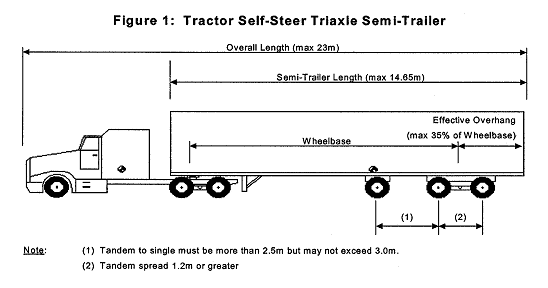
O. Reg. 668/00, s. 5.
(2) The tractor has the following characteristics:
1. It has a front axle equipped with single tires and a rear tandem axle that has an axle spread of 1.2 to 1.85 metres.
2. It is not equipped with a liftable axle or a self-steering axle, whether raised, lowered or rendered inoperative.
3. If the single axle of the semi-trailer is liftable, the tractor,
i. is not equipped with nor does it contain any device, whether remote or manual, that would allow the liftable axle to be controlled by the driver, and
ii. is not equipped with automatic controls that activate other than when reversing. O. Reg. 668/00, s. 5.
(3) The semi-trailer has the following characteristics:
1. It does not exceed 14.65 metres in length.
2. It has three axles, consisting of a front single axle and a rear tandem axle.
3. The inter-axle spacing between the single axle and the tandem axle is more than 2.5 metres but not more than 3 metres.
4. The single axle is a self-steering axle and is capable of turning 20 degrees in either direction.
5. The tandem axle has an axle spread of at least 1.2 metres.
6. The three axles automatically load equalize when the single axle is deployed.
7. The effective overhang does not exceed 35 per cent of the semi-trailer’s wheelbase.
8. If section 6 provides that it is to have a rear impact guard, it is equipped with a rear impact guard that meets the requirements of section 6.
9. If the single axle of the semi-trailer is liftable, the semi-trailer may be equipped with manual controls but may not be equipped with automatic controls that activate other than when reversing. O. Reg. 668/00, s. 5.
(4) The semi-trailer bears its original compliance label and the notation “Reg 597(Ont) — 3”, signifying that the semi-trailer was manufactured to the specifications in subsection (3), is on that label or the semi-trailer’s manufacturer’s identification plate. O. Reg. 668/00, s. 5.
(5) If the semi-trailer was not manufactured to the specifications in subsection (3),
(a) it has been converted by a company authorized under the Motor Vehicle Safety Act (Canada) to apply a national safety mark or by an authorized dealer of such a company;
(b) the person who converted it placed a label adjacent to the original compliance label indicating revised gross vehicle and axle weight ratings; and
(c) the notation “Reg 597(Ont) — 3”, signifying that the trailer was converted to the specifications in subsection (3), is on that label. O. Reg. 668/00, s. 5.
Self-Steer Quad Semi-Trailer
5. (1) For the purposes of sections 6, 7 and 10, a semi-trailer is a self-steer quad semi-trailer if,
(a) the combination of vehicles of which it forms part meets the description shown in Figure 2;
(b) the distance between the rear axle of the tractor and the single axle of the trailer is as described in subsection (2);
(c) the tractor is as described in subsection (3); and
(d) the semi-trailer shows evidence of,
(i) compliance under subsection (4) with respect to its manufacture, or
(ii) compliance under subsection (5) with respect to its conversion.
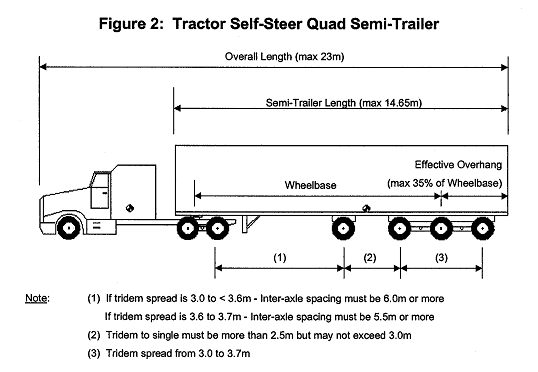
O. Reg. 668/00, s. 5.
(2) The distance between the rear axle of the tractor and the single axle of the trailer is,
(a) at least 6 metres, if the axle spread of the tridem axle of the semi-trailer is at least 3 metres and less than 3.6 metres; and
(b) at least 5.5 metres, if the axle spread of the tridem axle of the semi-trailer is at least 3.6 metres and not more than 3.7 metres. O. Reg. 668/00, s. 5.
(3) The tractor has the following characteristics:
1. It has a front axle equipped with single tires and a rear tandem axle that has an axle spread of at least 1.2 metres and not more than 1.85 metres.
2. It is not equipped with a liftable axle or a self-steering axle, whether raised, lowered or rendered inoperative.
3. If the single axle of the semi-trailer is liftable, the tractor,
i. is not equipped with nor does it contain any device, whether remote or manual, that would allow the liftable axle to be controlled by the driver, and
ii. is not equipped with automatic controls that activate other than when reversing. O. Reg. 668/00, s. 5.
(4) The semi-trailer has the following characteristics:
1. Its length does not exceed 14.65 metres.
2. It has four axles, consisting of a front single axle and a rear tridem axle.
3. The inter-axle spacing between the single axle and the tridem axle is more than 2.5 metres but not more than 3 metres.
4. The single axle is a self-steering axle and is capable of turning 20 degrees in either direction.
5. If the single axle is equipped with single tires, the width is imprinted on each of them and is least,
i. 365 millimetres, if the axle spread of the tridem axle is at least 3 metres and less than 3.6 metres, or
ii. 385 millimetres, if the axle spread of the tridem axle is at least 3.6 and not more than 3.7 metres.
6. The tridem axle has an axle spread of at least 3 metres and not more than 3.7 metres.
7. The four axles automatically load equalize when the single axle is deployed.
8. The effective overhang does not exceed 35 per cent of the semi-trailer’s wheelbase.
9. If it is required under section 6 to have a rear impact guard, it is equipped with a rear impact guard that meets the requirements of that section.
10. If the single axle of the semi-trailer is liftable, the semi-trailer may be equipped with manual controls but may not be equipped with automatic controls that activate other than when reversing.
10.1 If it is equipped with one liftable axle in addition to the axles required by paragraph 2, the additional axle is positioned in front of all other axles, and it is raised when the vehicle is operated on the highway.
11. It is equipped with,
i. a device that accurately displays the total weight on the trailer axles in kilograms, or
ii. a device and a table or chart, from the combined use of which the total weight on the trailer axles in kilograms may be readily and accurately obtained. O. Reg. 668/00, s. 5; O. Reg. 186/02, s. 3.
(5) The semi-trailer bears its original compliance label and the notation “Reg 597 (Ont) — 4”, signifying that the semi-trailer was manufactured to the specifications set out in subsection (4), is on that label or the semi-trailer’s manufacturer’s identification plate. O. Reg. 668/00, s. 5.
(6) If the semi-trailer was not manufactured to the specifications set out in subsection (4),
(a) it has been converted by a company authorized under the Motor Vehicle Safety Act (Canada) to apply a national safety mark or by an authorized dealer of such a company;
(b) that person placed a label adjacent to the original compliance label indicating revised gross vehicle and axle weight ratings; and
(c) that label includes the notation “Reg 597 (Ont) — 4”, signifying that the trailer was converted to the specifications in subsection (4). O. Reg. 668/00, s. 5.
Rear Impact Guards
6. (1) This section applies with respect to every self-steer triaxle semi-trailer described in section 4 and every self-steer quad semi-trailer described in section 5,
(a) that has an axle unit that can slide or is fixed so that the rear of the rearmost tire is more than 0.3 metres in from the rear of the trailer; and
(b) whose rear structure is more than 0.56 metres above the ground when the trailer is unladen on a level surface. O. Reg. 668/00, s. 5.
(2) The trailer shall be equipped with a rear impact guard that consists of a single horizontal beam that is rigidly attached to the trailer and that,
(a) extends to within 0.1 metres of each side of the trailer;
(b) is not more than 0.3 metres in front of the rear of the trailer and is as close to its rear as practicable; and
(c) is not more than 0.56 metres above the ground when the trailer is unladen on a level surface. O. Reg. 668/00, s. 5.
(3) A rear impact guard on a trailer, as shown in Figure 3, that is manufactured after January 26, 1998 shall meet the standards for such a guard under United States Federal Motor Vehicle Safety Standard 224, which became effective on January 26, 1998, or a corresponding standard, if any, under the Motor Vehicle Safety Act (Canada).
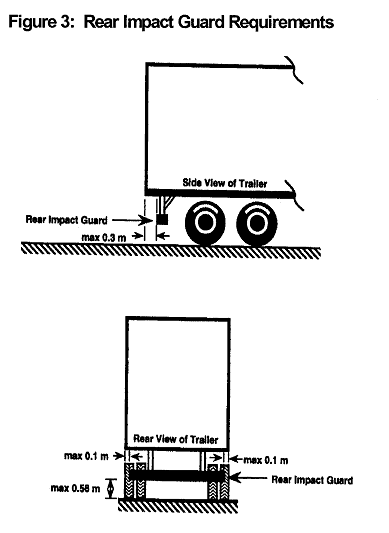
O. Reg. 668/00, s. 5.
Tire Exemption
7. The tires of the single axle of a self-steer quad semi-trailer are exempt from section 115 of the Act if they are single tires and comply with paragraph 5 of subsection 5 (4). O. Reg. 668/00, s. 5.
Triaxle and Dump Semi-Trailer Weight Reductions
8. (1) For combinations of vehicles to which this section applies and section 3 does not apply, maximum allowable gross vehicle weights for the purposes of section 118 of the Act shall be determined by subtracting the amounts in the applicable subsection of this section from the lowest of the following amounts:
1. The amount calculated under clause 118 (1) (a) of the Act.
2. The amount calculated under clause 118 (1) (b) of the Act.
3. The maximum allowable gross weight determined under section 2 of this Regulation. O. Reg. 186/02, s. 4.
(2) For combinations of vehicles to which both this section and section 3 apply, maximum allowable gross vehicle weights for the purposes of section 118 of the Act shall be determined by subtracting the amounts in the applicable subsection of this section from the amount permitted under section 3. O. Reg. 186/02, s. 4.
(3) Effective January 1, 2003, 4,500 kilograms shall be subtracted when the combination of vehicles includes a single end dump semi-trailer or open-top hopper dump semi-trailer manufactured in or after 2003 unless it is,
(a) a semi-trailer with no axles deployed other than a single axle;
(b) a semi-trailer with no axles deployed other than a tandem axle;
(c) a semi-trailer with no axles deployed other than a tridem axle;
(d) a self-steer triaxle semi-trailer; or
(e) a self-steer quad semi-trailer. O. Reg. 186/02, s. 4.
(4) Where two or more liftable axles are deployed on the semi-trailer that is part of the combination of vehicles to which subsection (3) applies, 9,000 kilograms shall be subtracted under that subsection instead of 4,500 kilograms. O. Reg. 186/02, s. 4.
(5) Effective January 1, 2006, 3,000 kilograms shall be subtracted when the combination of vehicles includes a single semi-trailer that is a triaxle semi-trailer unless it is,
(a) a self-steer triaxle semi-trailer;
(b) an open-top hopper dump semi-trailer;
(c) an end dump semi-trailer;
(d) a carbon dioxide tank semi-trailer;
(e) a cryogenic tank semi-trailer; or
(f) a tag-axle tank semi-trailer. O. Reg. 186/02, s. 4.
(6) Effective January 1, 2011, 4,500 kilograms shall be subtracted when the combination of vehicles includes a single semi-trailer that is a triaxle semi-trailer unless it is a self-steer triaxle semi-trailer or any type of tank semi-trailer. O. Reg. 186/02, s. 4.
(7) Effective January 1, 2011, 4,500 kilograms shall be subtracted when the combination of vehicles includes a single end dump semi-trailer or open-top hopper dump semi-trailer manufactured before 2003 unless it is,
(a) a semi-trailer with no axles deployed other than a single axle;
(b) a semi-trailer with no axles deployed other than a tandem axle;
(c) a semi-trailer with no axles deployed other than a tridem axle;
(d) a self-steer triaxle semi-trailer; or
(e) a self-steer quad semi-trailer. O. Reg. 186/02, s. 4.
(8) Where two or more liftable axles are deployed on the semi-trailer that is part of the combination of vehicles to which subsection (7) applies, 9,000 kilograms shall be subtracted under that subsection instead of 4,500 kilograms. O. Reg. 186/02, s. 4.
(9) Effective January 1, 2021, 4,500 kilograms shall be subtracted when the combination of vehicles includes a single triaxle semi-trailer that is a tank semi-trailer unless it is a self-steer triaxle semi-trailer. O. Reg. 186/02, s. 4.
(10) In this section, a combination of vehicles which is subject to a reduction of maximum allowable gross vehicle weight shall remain subject to that reduction unless the amount of the reduction is increased. O. Reg. 186/02, s. 4.
8.1 (1) The Registrar may issue a permit under clause 110.1 (1) (b) of the Act allowing a semi-trailer manufactured before January 1, 2003 that would otherwise be subject to subsection 8 (7) or (8) of this Regulation to operate without complying with those subsections. O. Reg. 186/02, s. 4.
(2) A permit described in subsection (1) may be issued for the purpose of allowing the continued use of a semi-trailer that was manufactured before January 1, 2003, but such permit shall be limited to the normal operating life of the semi-trailer and so may only allow non-compliance with those subsections,
(a) in the case of an end dump semi-trailer, for 15 years after the year of its manufacture;
(b) in the case of an open-top hopper dump semi-trailer, for 20 years after the year of its manufacture. O. Reg. 186/02, s. 4.
Tandem Axle Weight Increases
9. (1) Tandem axles with an axle spread of at least 1.2 metres and less than 1.6 metres are prescribed axle units for the purposes of section 116 of the Act when they form part of,
(a) a three axle tractor that has both a front single axle equipped with single tires and a rear tandem axle, but does not have a liftable axle or self-steering axle whether raised, lowered or rendered inoperative;
(b) a single semi-trailer that has no other axles deployed; or
(c) a self-steer triaxle semi-trailer. O. Reg. 668/00, s. 5.
(2) Instead of the maximum allowable axle unit weights specified in Table 1 of Part VIII of the Act, the prescribed weight for the axle units prescribed in subsection (1) is 18,000 kilograms. O. Reg. 668/00, s. 5.
Self-Steer Quad Tridem Axle Increases
10. (1) Tridem axles with an axle spread of at least 3 metres and not more than 3.7 metres are prescribed for the purposes of section 116 of the Act when they form part of a self-steer quad semi-trailer whose single axle is deployed. O. Reg. 668/00, s. 5.
(2) Instead of the maximum allowable axle unit weights specified in Table 2 of Part VIII of the Act, the prescribed weights for the axle units prescribed in subsection (1) are,
(a) 24,000 kilograms, if the axle spread is at least 3 metres and less than 3.6 metres; and
(b) 25,500 kilograms, if the axle spread is at least 3.6 metres and not more than 3.7 metres. O. Reg. 668/00, s. 5.
Other Tridem Axle Weight Increases
11. (1) Tridem axles with an axle spread of at least 3 metres and not more than 3.7 metres are prescribed for the purposes of section 116 of the Act when they form part of a single semi-trailer that has no other axles deployed. O. Reg. 668/00, s. 5.
(2) From January 1, 2001 until December 31, 2005, instead of the maximum allowable axle unit weights specified in Table 2 of Part VIII of the Act, the prescribed weight for the axle units prescribed in subsection (1) with an axle spread of at least 3.6 metres and not more than 3.7 metres is 25,500 kilograms. O. Reg. 668/00, s. 5.
(3) Effective January 1, 2006, instead of the maximum allowable axle unit weights specified in Table 2 of Part VIII of the Act, the prescribed weights for the axle units prescribed in subsection (1) are,
(a) 24,000 kilograms, if the axle spread is at least 3 metres and less than 3.6 metres; and
(b) 26,000 kilograms, if the axle spread is at least 3.6 and not more than 3.7 metres. O. Reg. 668/00, s. 5.
VEHICLE WEIGHT TABLE 1
ALLOWABLE GROSS WEIGHT ON A VEHICLE WITH THREE AXLES (KILOGRAMS)
FRONT AXLE WEIGHT, (KILOGRAMS)
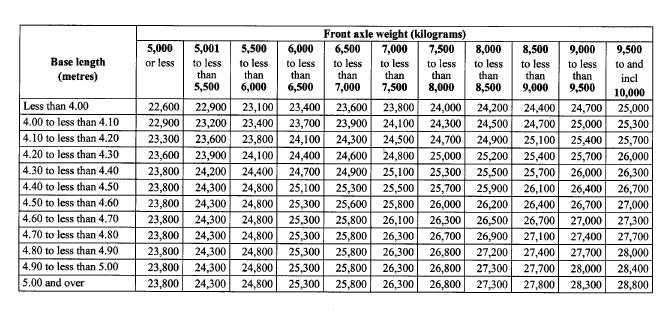
R.R.O. 1990, Reg. 597, Table 1.
VEHICLE WEIGHT TABLE 2
ALLOWABLE GROSS WEIGHT ON A VEHICLE WITH FOUR AXLES (KILOGRAMS)
FRONT AXLE WEIGHT, (KILOGRAMS)
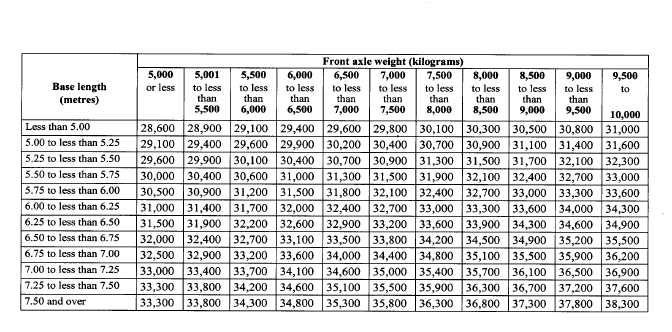
R.R.O. 1990, Reg. 597, Table 2.
VEHICLE WEIGHT TABLE 3
ALLOWABLE GROSS WEIGHT ON A VEHICLE WITH FIVE AXLES (KILOGRAMS)
INTER-VEHICLE-UNIT DISTANCE, LESS THAN 2.4 METRES
(OR INTRA-VEHICLE-UNIT DISTANCE)
FRONT AXLE WEIGHT, (KILOGRAMS)
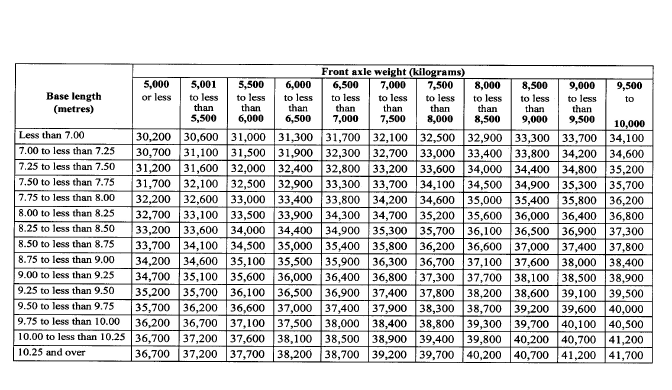
R.R.O. 1990, Reg. 597, Table 3.
VEHICLE WEIGHT TABLE 4
ALLOWABLE GROSS WEIGHT ON A VEHICLE WITH FIVE AXLES (KILOGRAMS)
INTER-VEHICLE-UNIT DISTANCE, 2.4 METRES TO LESS THAN 2.7 METRES
(OR INTRA-VEHICLE-UNIT DISTANCE)
FRONT AXLE WEIGHT, (KILOGRAMS)
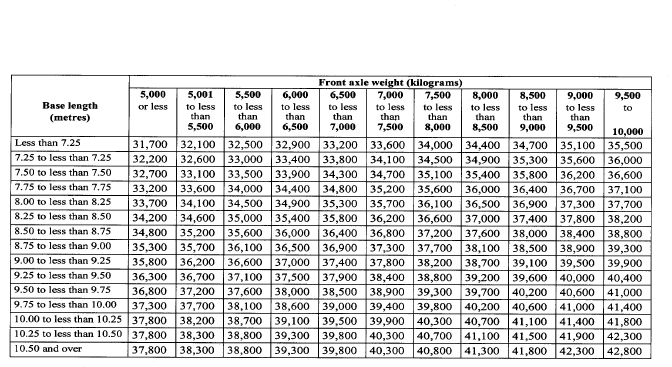
R.R.O. 1990, Reg. 597, Table 4.
VEHICLE WEIGHT TABLE 5
ALLOWABLE GROSS WEIGHT ON A VEHICLE WITH FIVE AXLES (KILOGRAMS)
INTER-VEHICLE-UNIT DISTANCE, 2.7 METRES TO LESS THAN 3.0 METRES
(OR INTRA-VEHICLE-UNIT DISTANCE)
FRONT AXLE WEIGHT, (KILOGRAMS)
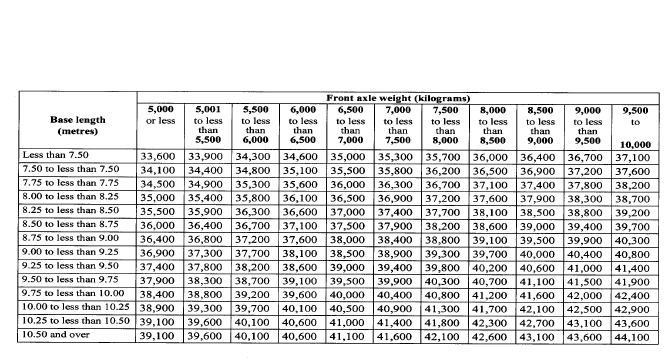
R.R.O. 1990, Reg. 597, Table 5.
VEHICLE WEIGHT TABLE 6
ALLOWABLE GROSS WEIGHT ON A VEHICLE WITH FIVE AXLES (KILOGRAMS)
INTER-VEHICLE-UNIT DISTANCE, 3.0 METRES TO LESS THAN 3.3 METRES
(OR INTRA-VEHICLE-UNIT DISTANCE)
FRONT AXLE WEIGHT, (KILOGRAMS)
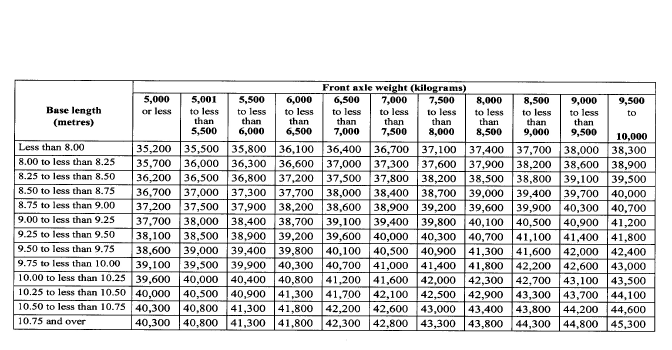
R.R.O. 1990, Reg. 597, Table 6.
VEHICLE WEIGHT TABLE 7
ALLOWABLE GROSS WEIGHT ON A VEHICLE WITH FIVE AXLES (KILOGRAMS)
INTER-VEHICLE-UNIT DISTANCE, 3.3 METRES TO LESS THAN 3.6 METRES
(OR INTRA-VEHICLE-UNIT DISTANCE)
FRONT AXLE WEIGHT, (KILOGRAMS)
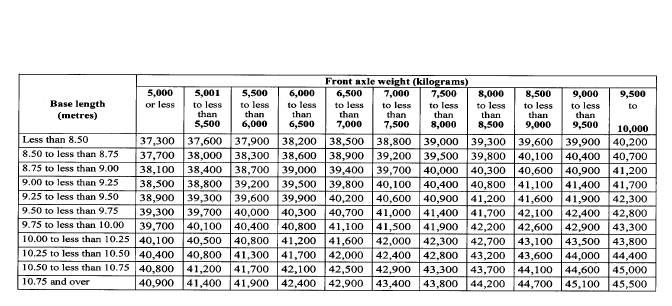
R.R.O. 1990, Reg. 597, Table 7.
VEHICLE WEIGHT TABLE 8
ALLOWABLE GROSS WEIGHT ON A VEHICLE WITH FIVE AXLES (KILOGRAMS)
INTER-VEHICLE-UNIT DISTANCE, 3.6 METRES OR MORE
(OR INTRA-VEHICLE-UNIT DISTANCE)
FRONT AXLE WEIGHT, (KILOGRAMS)
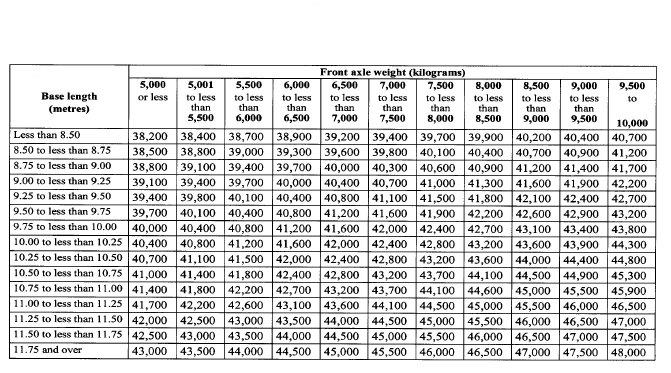
R.R.O. 1990, Reg. 597, Table 8.
VEHICLE WEIGHT TABLE 9
ALLOWABLE GROSS WEIGHT ON A VEHICLE WITH SIX AXLES (KILOGRAMS)
INTER-VEHICLE-UNIT DISTANCE, LESS THAN 2.1 METRES
(OR INTRA-VEHICLE-UNIT DISTANCE)
FRONT AXLE WEIGHT, (KILOGRAMS)
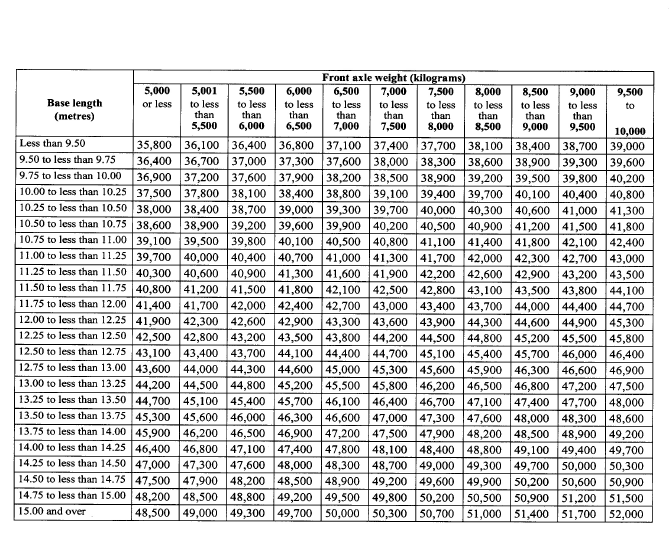
R.R.O. 1990, Reg. 597, Table 9; O. Reg. 355/96, s. 3 (1).
VEHICLE WEIGHT TABLE 10
ALLOWABLE GROSS WEIGHT ON A VEHICLE WITH SIX AXLES (KILOGRAMS)
INTER-VEHICLE-UNIT DISTANCE, 2.1 METRES TO LESS THAN 2.4 METRES
(OR INTRA-VEHICLE-UNIT DISTANCE)
FRONT AXLE WEIGHT, (KILOGRAMS)
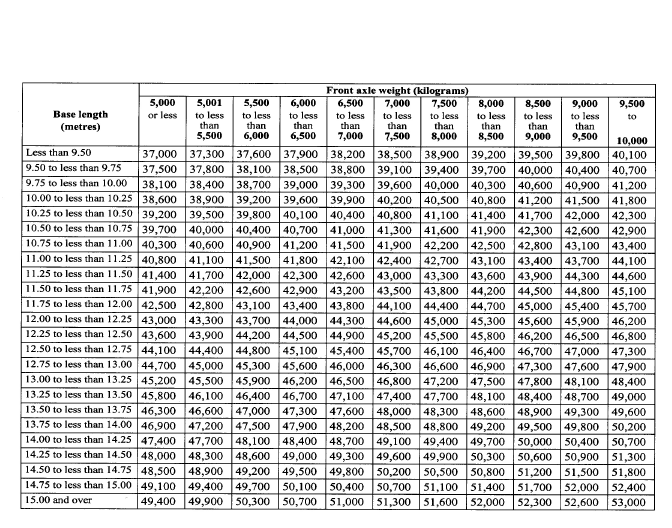
R.R.O. 1990, Reg. 597, Table 10; O. Reg. 355/96, s. 3 (1).
VEHICLE WEIGHT TABLE 11
ALLOWABLE GROSS WEIGHT ON A VEHICLE WITH SIX AXLES (KILOGRAMS)
INTER-VEHICLE-UNIT DISTANCE, 2.4 METRES TO LESS THAN 2.7 METRES
(OR INTRA-VEHICLE-UNIT DISTANCE)
FRONT AXLE WEIGHT, (KILOGRAMS)
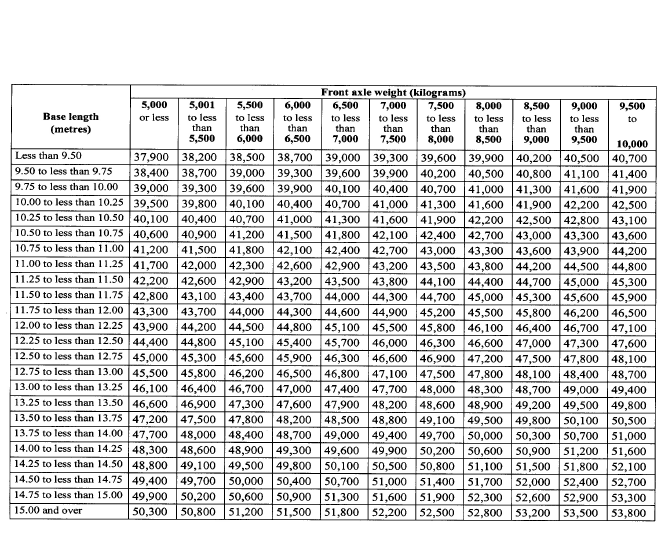
R.R.O. 1990, Reg. 597, Table 11; O. Reg. 355/96, s. 3 (1).
VEHICLE WEIGHT TABLE 12
ALLOWABLE GROSS WEIGHT ON A VEHICLE WITH SIX AXLES (KILOGRAMS)
INTER-VEHICLE-UNIT DISTANCE, 2.7 METRES TO LESS THAN 3.0 METRES
(OR INTRA-VEHICLE-UNIT DISTANCE)
FRONT AXLE WEIGHT, (KILOGRAMS)
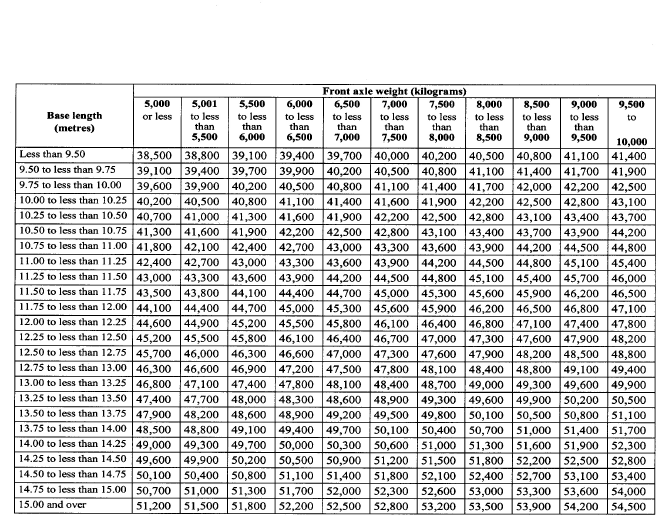
R.R.O. 1990, Reg. 597, Table 12; O. Reg. 355/96, s. 3 (1).
VEHICLE WEIGHT TABLE 13
ALLOWABLE GROSS WEIGHT ON A VEHICLE WITH SIX AXLES (KILOGRAMS)
INTER-VEHICLE-UNIT DISTANCE, 3.0 METRES TO LESS THAN 3.3 METRES
(OR INTRA-VEHICLE-UNIT DISTANCE)
FRONT AXLE WEIGHT, (KILOGRAMS)
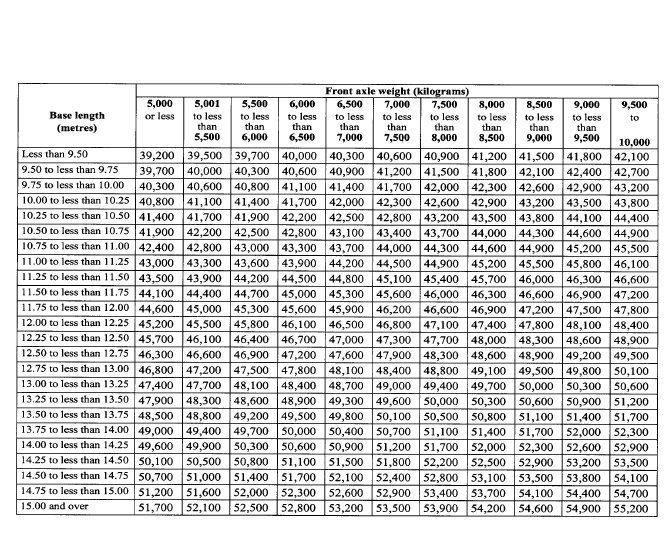
R.R.O. 1990, Reg. 597, Table 13; O. Reg. 355/96, s. 3 (1).
VEHICLE WEIGHT TABLE 14
ALLOWABLE GROSS WEIGHT ON A VEHICLE WITH SIX AXLES (KILOGRAMS)
INTER-VEHICLE-UNIT DISTANCE, 3.3 METRES TO LESS THAN 3.6 METRES
(OR INTRA-VEHICLE-UNIT DISTANCE)
FRONT AXLE WEIGHT, (KILOGRAMS)
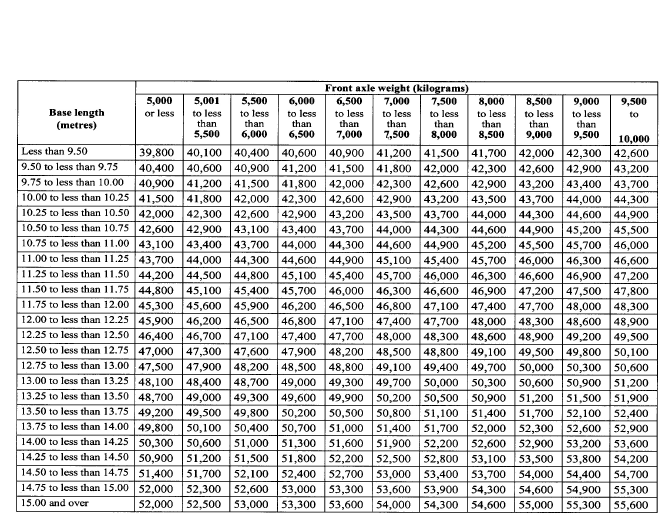
R.R.O. 1990, Reg. 597, Table 14; O. Reg. 355/96, s. 3 (1).
VEHICLE WEIGHT TABLE 15
ALLOWABLE GROSS WEIGHT ON A VEHICLE WITH SIX AXLES (KILOGRAMS)
INTER-VEHICLE-UNIT DISTANCE, 3.6 METRES OR MORE
(OR INTRA-VEHICLE-UNIT DISTANCE)
FRONT AXLE WEIGHT, (KILOGRAMS)
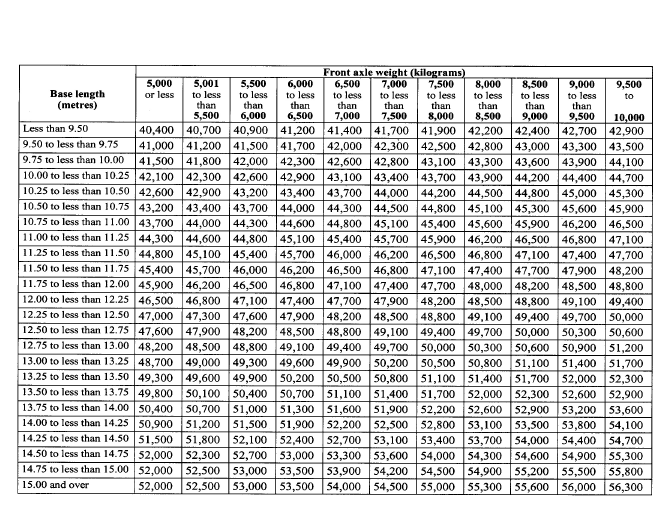
R.R.O. 1990, Reg. 597, Table 15; O. Reg. 355/96, s. 3 (1).
VEHICLE WEIGHT TABLE 16
ALLOWABLE GROSS WEIGHT ON A VEHICLE WITH SEVEN AXLES (KILOGRAMS)
INTER-VEHICLE-UNIT DISTANCE, LESS THAN 2.1 METRES
FRONT AXLE WEIGHT, (KILOGRAMS)
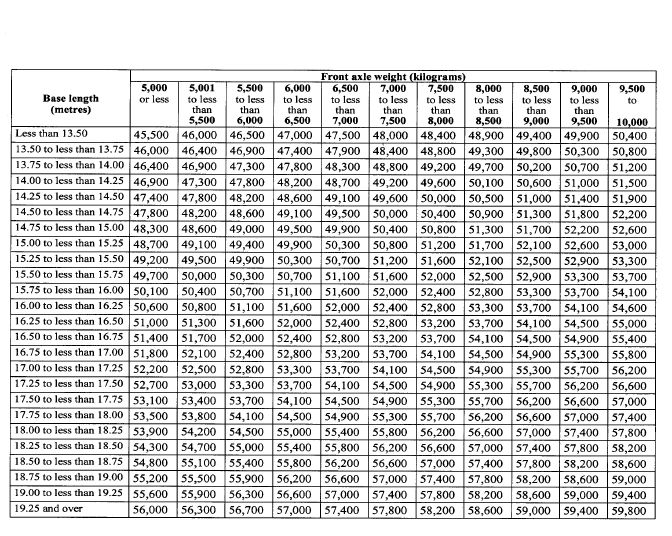
R.R.O. 1990, Reg. 597, Table 16.
VEHICLE WEIGHT TABLE 17
ALLOWABLE GROSS WEIGHT ON A VEHICLE WITH SEVEN AXLES (KILOGRAMS)
INTER-VEHICLE-UNIT DISTANCE, 2.1 METRES TO LESS THAN 2.4 METRES
FRONT AXLE WEIGHT, (KILOGRAMS)
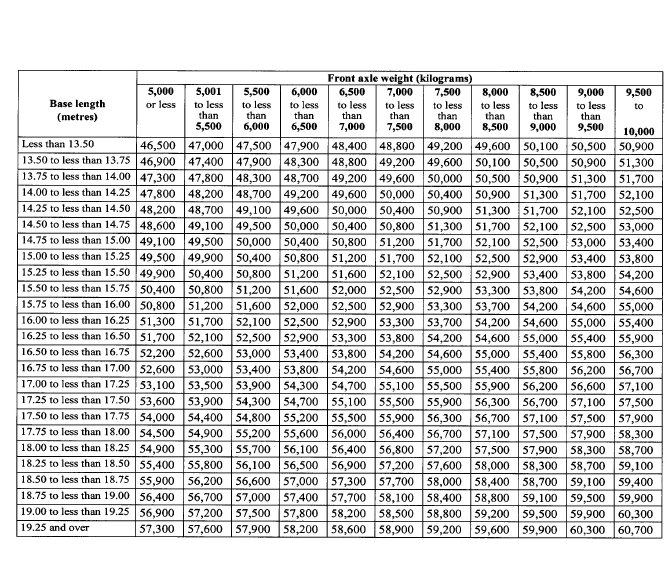
R.R.O. 1990, Reg. 597, Table 17.
VEHICLE WEIGHT TABLE 18
ALLOWABLE GROSS WEIGHT ON A VEHICLE WITH SEVEN AXLES (KILOGRAMS)
INTER-VEHICLE-UNIT DISTANCE, 2.4 METRES TO LESS THAN 2.7 METRES
FRONT AXLE WEIGHT, (KILOGRAMS)
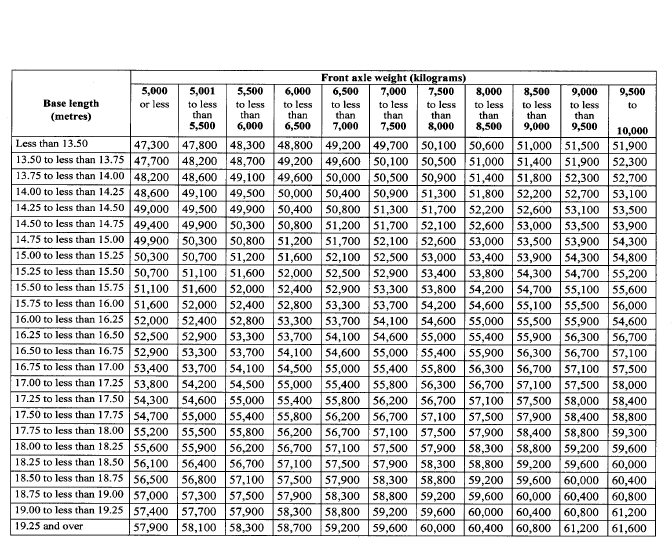
R.R.O. 1990, Reg. 597, Table 18.
VEHICLE WEIGHT TABLE 19
ALLOWABLE GROSS WEIGHT ON A VEHICLE WITH SEVEN AXLES (KILOGRAMS)
INTER-VEHICLE-UNIT DISTANCE, 2.7 METRES TO LESS THAN 3.0 METRES
FRONT AXLE WEIGHT, (KILOGRAMS)
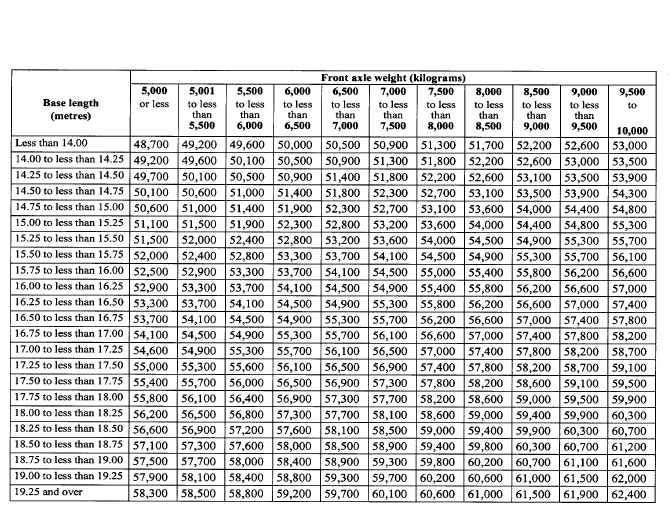
R.R.O. 1990, Reg. 597, Table 19.
VEHICLE WEIGHT TABLE 20
ALLOWABLE GROSS WEIGHT ON A VEHICLE WITH SEVEN AXLES (KILOGRAMS)
INTER-VEHICLE-UNIT DISTANCE, 3.0 METRES TO LESS THAN 3.3 METRES
FRONT AXLE WEIGHT, (KILOGRAMS)
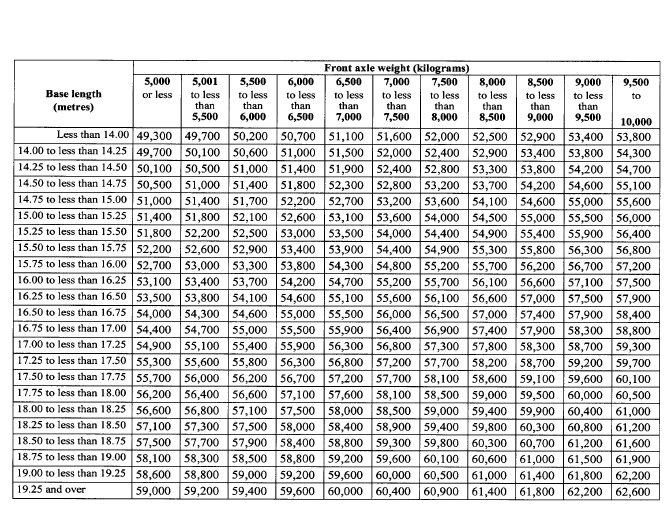
R.R.O. 1990, Reg. 597, Table 20.
VEHICLE WEIGHT TABLE 21
ALLOWABLE GROSS WEIGHT ON A VEHICLE WITH SEVEN AXLES (KILOGRAMS)
INTER-VEHICLE-UNIT DISTANCE, 3.3 METRES TO LESS THAN 3.6 METRES
FRONT AXLE WEIGHT, (KILOGRAMS)
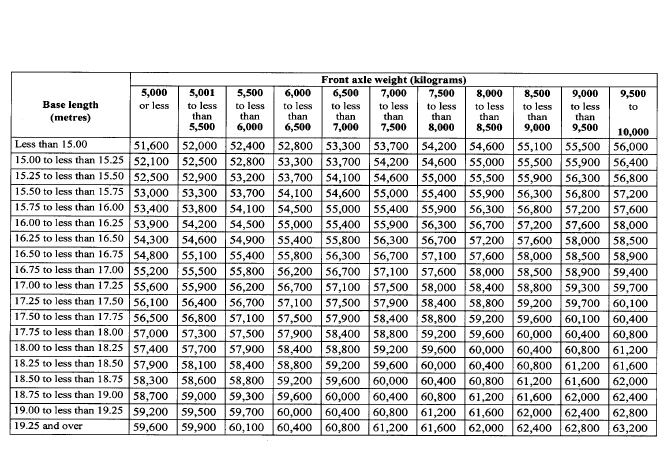
R.R.O. 1990, Reg. 597, Table 21.
VEHICLE WEIGHT TABLE 22
ALLOWABLE GROSS WEIGHT ON A VEHICLE WITH SEVEN AXLES (KILOGRAMS)
INTER-VEHICLE-UNIT DISTANCE, 3.6 METRES OR MORE
FRONT AXLE WEIGHT, (KILOGRAMS)
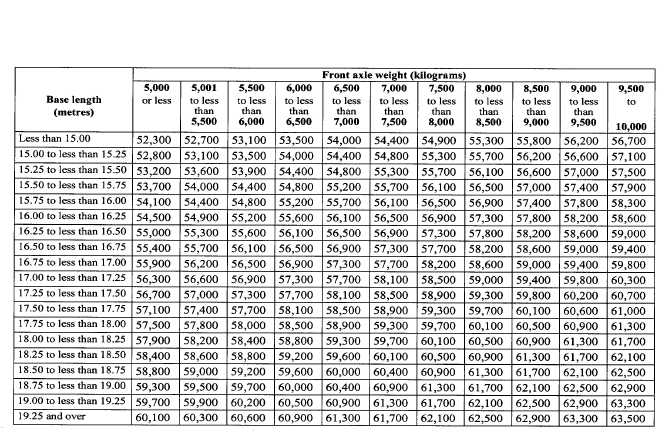
R.R.O. 1990, Reg. 597, Table 22.
VEHICLE WEIGHT TABLE 23
ALLOWABLE GROSS WEIGHT ON A VEHICLE WITH EIGHT OR MORE AXLES (KILOGRAMS)
INTER-VEHICLE-UNIT DISTANCE, LESS THAN 2.1 METRES
FRONT AXLE WEIGHT, (KILOGRAMS)
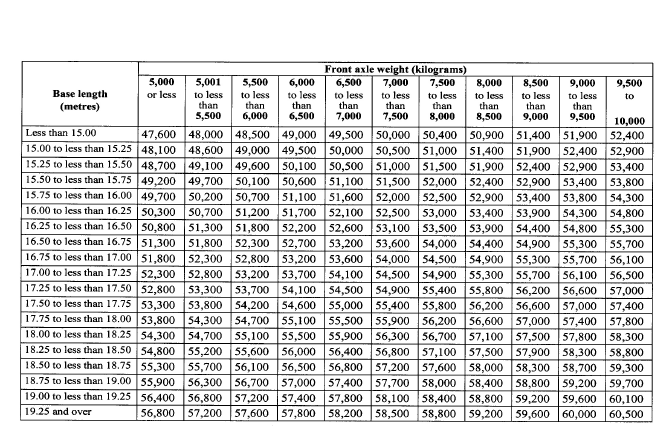
R.R.O. 1990, Reg. 597, Table 23.
VEHICLE WEIGHT TABLE 24
ALLOWABLE GROSS WEIGHT ON A VEHICLE WITH EIGHT OR MORE AXLES (KILOGRAMS)
INTER-VEHICLE-UNIT DISTANCE, 2.1 METRES TO LESS THAN 2.4 METRES
FRONT AXLE WEIGHT, (KILOGRAMS)
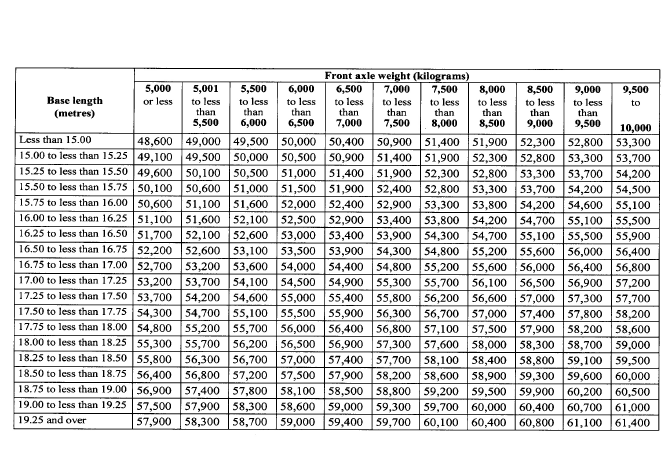
R.R.O. 1990, Reg. 597, Table 24.
VEHICLE WEIGHT TABLE 25
ALLOWABLE GROSS WEIGHT ON A VEHICLE WITH EIGHT OR MORE AXLES (KILOGRAMS)
INTER-VEHICLE-UNIT DISTANCE, 2.4 METRES TO LESS THAN 2.7 METRES
FRONT AXLE WEIGHT, (KILOGRAMS)
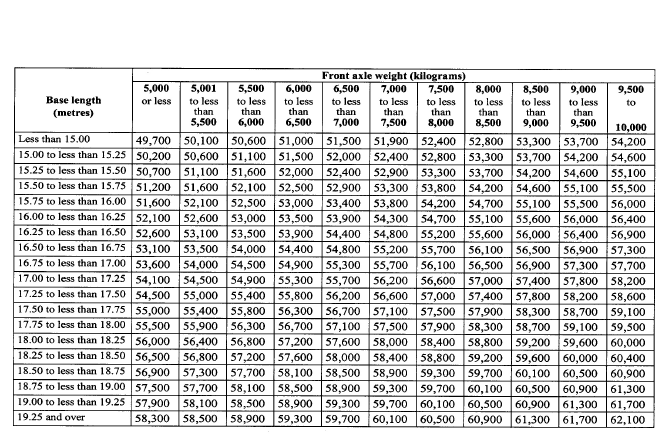
R.R.O. 1990, Reg. 597, Table 25.
VEHICLE WEIGHT TABLE 26
ALLOWABLE GROSS WEIGHT ON A VEHICLE WITH EIGHT OR MORE AXLES (KILOGRAMS)
INTER-VEHICLE-UNIT DISTANCE, 2.7 METRES TO LESS THAN 3.0 METRES
FRONT AXLE WEIGHT, (KILOGRAMS)
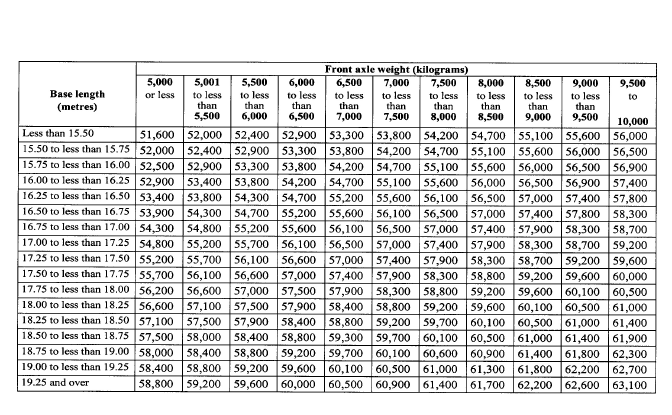
R.R.O. 1990, Reg. 597, Table 26.
VEHICLE WEIGHT TABLE 27
ALLOWABLE GROSS WEIGHT ON A VEHICLE WITH EIGHT OR MORE AXLES (KILOGRAMS)
INTER-VEHICLE-UNIT DISTANCE, 3.0 METRES TO LESS THAN 3.3 METRES
FRONT AXLE WEIGHT, (KILOGRAMS)
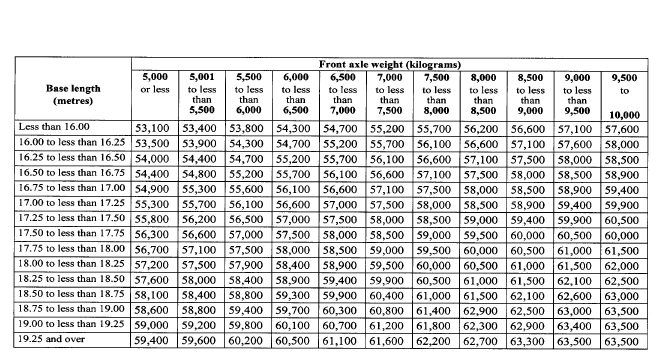
O. Reg. 355/96, s. 3 (2).
VEHICLE WEIGHT TABLE 28
ALLOWABLE GROSS WEIGHT ON A VEHICLE WITH EIGHT OR MORE AXLES (KILOGRAMS)
INTER-VEHICLE-UNIT DISTANCE, 3.3 METRES TO LESS THAN 3.6 METRES
FRONT AXLE WEIGHT, (KILOGRAMS)
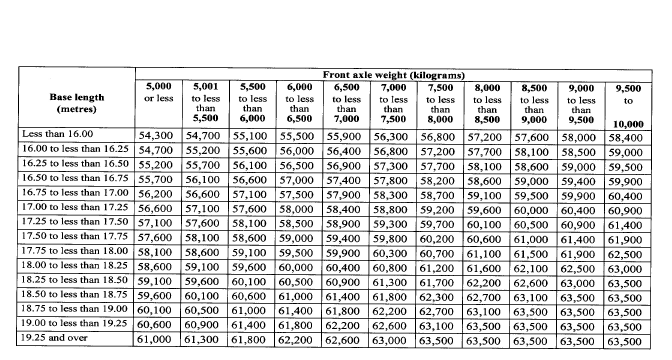
R.R.O. 1990, Reg. 597, Table 28.
VEHICLE WEIGHT TABLE 29
ALLOWABLE GROSS WEIGHT ON A VEHICLE WITH EIGHT OR MORE AXLES (KILOGRAMS)
INTER-VEHICLE-UNIT DISTANCE, 3.6 METRES OR MORE
FRONT AXLE WEIGHT, (KILOGRAMS)
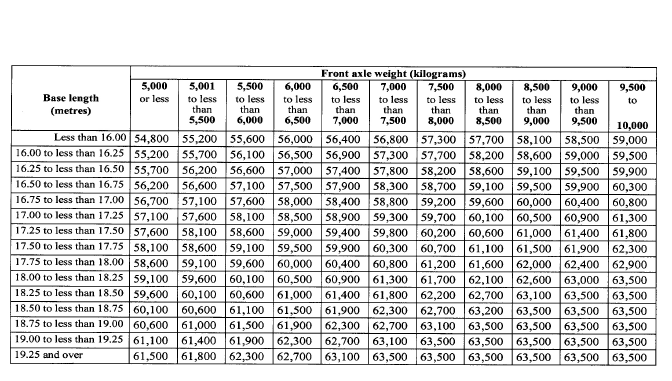
R.R.O. 1990, Reg. 597, Table 29.